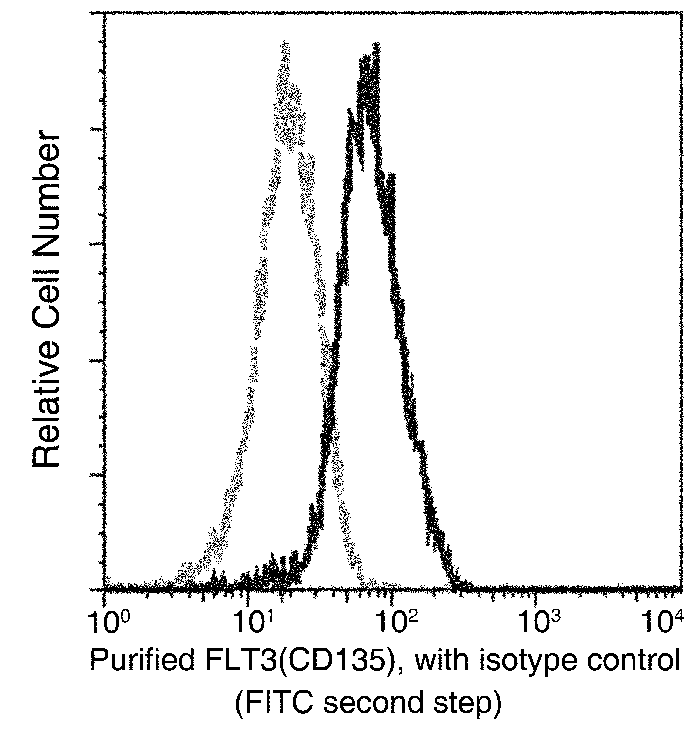-
Product Name
Anti-FLT-3/CD135/FLK-2 antibody
- Documents
-
Description
Mouse monoclonal to FLT-3/CD135/FLK-2
-
Tested applications
FCM
-
Species reactivity
Human FLT-3 / CD135 / FLK-2
-
Alternative names
B230315G04 antibody; CD135 antibody; CD135 antibody; Flk2 antibody; FLK2 antibody; Flk-2 antibody; FLT3 antibody; Flt3 antibody; Flt-3 antibody; Ly72 antibody; MGC124377 antibody; MGC124378 antibody; RP11-153M24.3 antibody; STK1 antibody; FLK2 antibody; STK1 antibody; CD135 antibody; FLK-2 antibody; Flk2 antibody; Ly72 antibody; wmfl antibody; CD135 antibody; Flk-2 antibody; Flt-3 antibody; B230315G04 antibody
- Immunogen
-
Isotype
Mouse IgG1
-
Preparation
This antibody was produced from a hybridoma resulting from the fusion of a mouse myeloma with B cells obtained from a mouse immunized with purified, recombinant Human FLT-3 / CD135 / FLK-2 (rh FLT-3 / CD135 / FLK-2; NP_004110.2; Met1-Asn541). The IgG fraction of the cell culture supernatant was purified by Protein A affinity chromatography.
-
Clonality
Monoclonal
-
Formulation
0.2 μm filtered solution in PBS
-
Storage instructions
This antibody can be stored at 2℃-8℃ for one month without detectable loss of activity. Antibody products are stable for twelve months from date of receipt when stored at -20℃ to -80℃. Preservative-Free.
Sodium azide is recommended to avoid contamination (final concentration 0.05%-0.1%). It is toxic to cells and should be disposed of properly. Avoid repeated freeze-thaw cycles. -
Applications
FCM: 0.5-2 μg/Test
-
Validations

FLT-3 / CD135 / FLK-2 Antibody, Mouse MAb, Flow Cytometry
Flow cytometric analysis of Human FLT3(CD135) expression on Human blood monocytes. Cells were stained with purified anti-Human FLT3(CD135), then a FITC-conjugated second step antibody. The histogram were derived from gated events with the forward and side light-scatter characteristics of viable monocytes.
-
Background
The cluster of differentiation (CD) system is commonly used as cell markers in immunophynotyping. Different kinds of cells in the immune system can be identified through the surface CD molecules which associating with the immune function of the cell. There are more than 320 CD unique clusters and subclusters have been identified. Some of the CD molecules serve as receptors or ligands important to the cell through initiating a signal cascade which then alter the behavior of the cell. Some CD proteins do not take part in cell signal process but have other functions such as cell adhesion. CD135, also known as FLT-3, FLK-2, is a member of the CD system. CD135 is an important cell surface marker recognized by specific sets of antibodies to identify the types of hematopoietic (blood) progenitors in the bone marrow and it function to differentiate hematopoietic stem cells, which are CD135 negative, from multipotent progenitors, which are CD135 positive. CD135 is a receptor tyrosine kinase typeⅢ for the cytokine Flt3 ligand and activat signaling through second messengers by binding to Flt3. Signaling through CD135 is important for lymphocyte development. The encoding gene CD135 is a proto-oncogene to which mutations happened will lead to cancer such as leukemia.
-
References
- Zola H, et al. (2007) CD molecules 2006-human cell differentiation molecules. J Immunol Methods. 318 (1-2): 1-5.
- Ho IC, et al. (2009) GATA3 and the T-cell lineage: essential functions before and after T-helper-2-cell differentiation. Nat Rev Immunol. 9 (2): 125-35.
- Matesanz-Isabel J, et al. (2011) New B-cell CD molecules. Immunology Letters.134 (2): 104-12.
- Bertho, et al. (2000) CD135 (Flk2 / Flt3) Expression by Human Thymocytes Delineates a Possible Role of FLT3-Ligand in T-Cell Precursor Proliferation and Differentiation. Scandinavian Journal of Immunology. 52 (1): 53-61.
Related Products / Services
Please note: All products are "FOR RESEARCH USE ONLY AND ARE NOT INTENDED FOR DIAGNOSTIC OR THERAPEUTIC USE"
